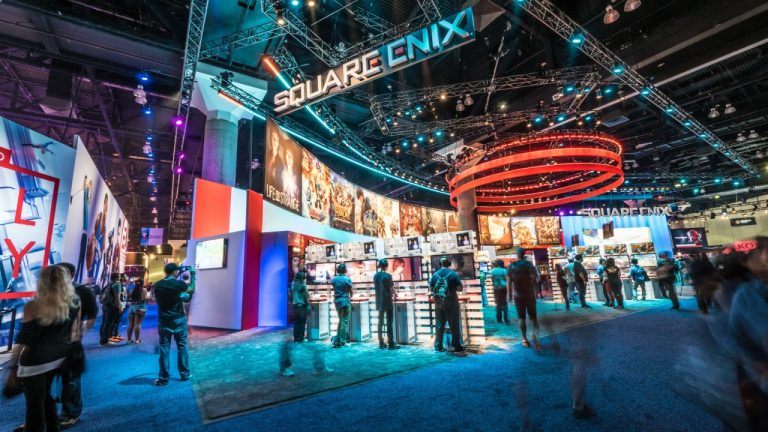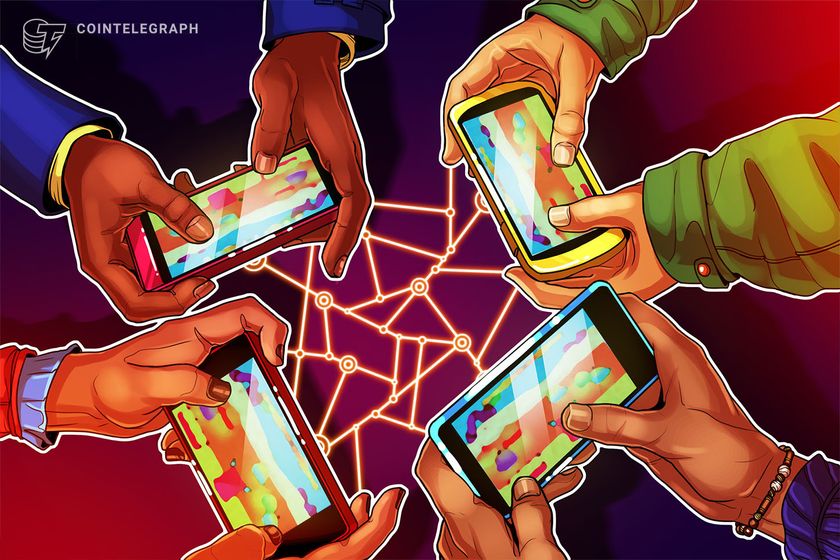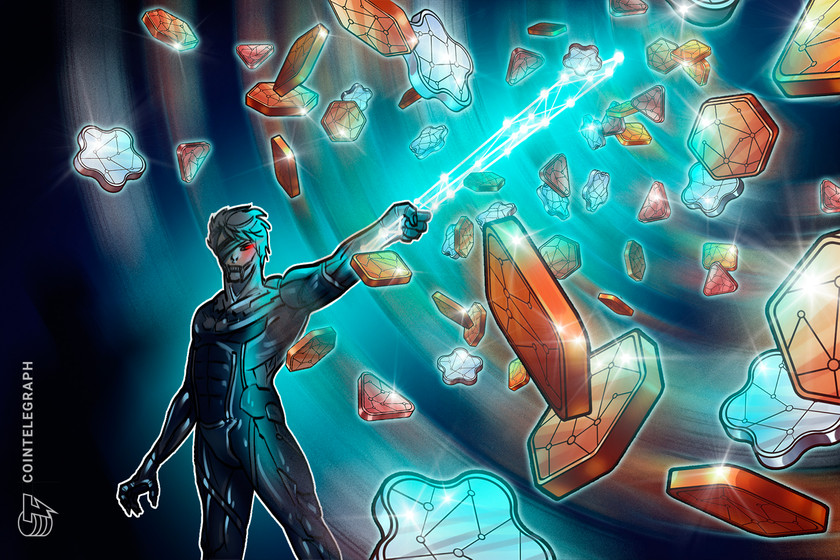 Soccerverse, a massively multiplayer football management game, has successfully raised $3.1 million in a strategic funding round led by renowned games industry publisher Square Enix, with additional participation from early investor Hiro Capital. This brings the total funding to $4 million. Founded by ex-Soccer Manager CEO Andrew Gore and blockchain gaming pioneers Andrew Colosimo and […]
Soccerverse, a massively multiplayer football management game, has successfully raised $3.1 million in a strategic funding round led by renowned games industry publisher Square Enix, with additional participation from early investor Hiro Capital. This brings the total funding to $4 million. Founded by ex-Soccer Manager CEO Andrew Gore and blockchain gaming pioneers Andrew Colosimo and […]

Gaming studio founders Yat Siu and Johnson Yeh think more people are coming to Web3 next year — and blockchain games are why.
Crypto market hype and the “commercial release” of several highly anticipated blockchain games will likely onboard “tens of millions” gamers to Web3 in 2024, according to Web3 gaming execs.
“2024 is a growth year in terms of bringing people on to Web3,” said Yat Siu, co-founder of gaming and venture firm Animoca Brands, in an interview with Cointelegraph.
In the last three months, around 1 million — or more — unique active wallets have played Web3 games daily, according to DappRadar data. However, Siu believes there could be up to 100 million more next year.

Polemos co-founder Richard McLaren believes the future of blockchain gaming will involve gamers and developers renting out their in-game NFTs for profit.
Imagine a future where a player is able to rent an in-game item via blockchain, giving them tools to pass a difficult level, or borrow an NFT that gives them the ability to try a new game on their wishlist.
Such a feature is one that Polemos co-founder Richard McLaren is hoping will one day become the norm, along with an economy where players rent out their in-game assets for a fee.
In an interview with Cointelegraph, McLaren announced a new partnership between his gaming infrastructure service Polemos and fantasy battle game Illuvium, a move he said would help break down barriers for players looking to get started on Illivium’s platform.

Crypto games have garnered a bad reputation among traditional gamers, but the future of Web3 games and blockchain-based worlds is far from over, says Nolan Bushnell.
It’s no secret that traditional gamers harbor a strong sense of disdain for crypto and nonfungible tokens (NFTs) in their games. The reason for this is clear, says Atari founder Nolan Bushnell, it all started with the insane rise of play-to-earn games.
“I can tell you clearly where this disdain for crypto comes from,” Bushnell said. “The hatred comes from these play-to-earn games that pioneered blockchain gaming.”
“Good gamers don’t like to grind. Grinding is shitty. What gamers want is fun, and unfortunately these play-to-earn games are 100% dependent on the greater fool theory to work.”
Speaking to Cointelegraph in a wide-ranging interview, Bushnell — known as the “godfather of video games” — shared his many perspectives on the current gaming landscape and the role blockchain technology will play in the sector moving forward.
While it could be seen as outlandish if someone said that they had “invented video games” — for Bushnell, this was just a part of his long career, including founding the gaming system Atari and the American dining chain Chuck E. Cheese. He is also one of the few people in the world to have counted Steve Jobs as an employee.

Bushnell believes the future of Web3 gaming depends on a major shift away from play-to-earn dynamics and a renewed focus on building convincing virtual worlds through the use of virtual reality (VR) and augmented reality (AR) technology.
The mass adoption of these new worlds, Bushnell explains, will be entirely dependent upon the human need for socialization as well as a permanent sense of “place and time” in the new economy of virtual worlds.
“How do you meet people? Where do you meet them? Where do you meet them? That’s the connective tissue of Web3 and the metaverse. If you can provide this sense of real place and real time in virtual worlds, that’s when I think we've really got something.”
Presently, Bushnell serves as the chief knowledge officer at Moxy, a new blockchain-based esports company, where he describes three pillars where blockchain can provide modern gaming with a much-needed upgrade.
I'm excited to be speaking at the DELF event. We've chosen Hong Kong for https://t.co/GNemkV0YDf's entrance to the Asian Market https://t.co/phUuANd9LB
— Nolan K Bushnell (@NolanBushnell) August 15, 2023
The first and most important value proposition Bushnell says is the ability to transfer seamlessly and securely.
“We want to turn gaming into a platform for competition and in order to have good competition, you need to be able to securely transfer funds simply and easily,” he explained.
As the world becomes increasingly digital, there needs to be a way for people to ensure that actions and expectations are aligned with outcomes.
“Number two, and it's a close two by the way, is the utility of smart contracts. Smart contracts don’t just have value in games but in all human interactions, because so much of what we do in life is establish relationships and then set the terms of those relationships.”
The third key area is the ability to securely store the value of digital assets in the form of currencies and tokens.
Related: Atari founder, Animoca sees Web3 games as vital for virtual ownership and education
First introduced to cryptocurrency by Tether co-founder Brock Pierce, when Bitcoin (BTC) was hovering around the price of $50, Bushnell said he didn’t take too much notice of crypto at first.
However, like many others, he changed his minds when the price of Bitcoin began to surge, and suddenly Bushnell realized that there might be something more going on in the world of blockchain.
While Bushnell admits that he doesn’t have much material exposure to cryptocurrencies due to the volatile nature of prices, he concluded that anytime humans are capable of sharing a perception of value en masse, “we’re usually in the clear.”
Web3 Gamer: GTA owner joins Web3, Bitcoin casino, Sunflower Land review
 After recording $4.26 billion in total non-fungible token (NFT) sales, the play-to-earn game Axie Infinity’s monthly player count has dropped to levels not seen since November 2020, a period of 26 months. Despite the low player count, the project’s native token, AXS, has climbed 62% higher against the U.S. dollar in the last 30 days. […]
After recording $4.26 billion in total non-fungible token (NFT) sales, the play-to-earn game Axie Infinity’s monthly player count has dropped to levels not seen since November 2020, a period of 26 months. Despite the low player count, the project’s native token, AXS, has climbed 62% higher against the U.S. dollar in the last 30 days. […]
Despite a tumultuous year, DeFi, NFTs and blockchain games drove DApp usage across the industry, according to DappRadar’s 2022 report.
2022 will go down as a challenging year for the cryptocurrency and blockchain space, but the adversity faced has been strewn with plenty of positives for the decentralized application (DApp) ecosystem.
DappRadar has released its yearly report on the industry, focusing on challenges faced alongside notable technological achievements and an increasing number of active daily users.
Cointelegraph highlights the main takeaways from the DApp industry in 2022, which are pertinent, considering macro factors like inflationary concerns in major economies, the collapse of industry-specific projects like Terra/Luna and FTX, as well as market woes across the board.
Perhaps most telling is unique active wallet data (UAW) from 2021 and 2022, demonstrating a 50% increase in the average daily UAW year on year. This is up from 1.58 million daily users in 2021 to an average of 2.37 million daily active users in 2022.

It must be noted that there was a downtrend of DApp users from February 2022, which DappRadar associated with the escalating war in Ukraine as well as crypto-specific black swan events, including Terra/Luna and FTX’s collapse.
The decentralized finance (DeFi) industry was particularly affected in the wake of Terra’s TerraUSD (UST) depeg and the resulting cryptocurrency market decline, with a significant drop in total value locked (TVL) of around 73% to $55 billion as of December 2022.
Related: Gaming makes up over half of blockchain industry usage, DappRadar
Layer-1 DeFi protocols saw the biggest drop in TVL, with Ethereum experiencing a 74.5% reduction to $32.12 billion TVL, while the second biggest DeFi ecosystem, BNB Chain, recorded a 62.5% drop in TVL in 2022. Layer-2 protocols fared slightly better, with Arbitrum falling 12% to $1.74 billion. Optimism’s TVL increased by 127.60%, hitting $669 million.
On-chain data for nonfungible token (NFT) trading volume was in contrast to DeFi’s year-to-date. NFT trading volume increased by just 0.41% year on year, while the number of unique traders increased by a staggering 876% to reach 10.6 million users in 2022. NFT sales also trended positively, increasing by 10.6% to reach 68.35 million. OpenSea remains the most popular NFT marketplace, accounting for 73% of organic NFT trading volume.
Blockchain games played a significant role in the DApp space, accounting for 49% of activity in 2022, with an average of 1.15 million daily UAW. In total, the sector produced 7.4 billion transactions this year.
Blockchain-powered trading card game Splinterlands was the most popular platform, according to DappRadar, growing by 85% to reach 217,914 monthly unique active wallets in 2022.
Terra’s implosion accounts for $40 billion of funds lost, while DappRadar estimated the median loss per hack was around $283,000 and losses per month were pinned at $728 million.
DappRadar integrated 49 blockchains, tracked 13,000 DApps and 13,500 NFT collections and noted that the increased number of DApps reflects the resilience and potential of the sector, with projects continuing to build and innovate despite a challenging macro environment.
Hacks, thefts and rug pulls are also featured in DappRadar’s 2022 review. A total of 312 attacks resulted in total losses of $48.74 billion across the board, the highest amount on record since Bitcoin’s inception back in 2009.

As the downfall of FTX continues to push the crypto markets deeper into red territory, DappRadar says that one sector of the industry remains largely unaffected by the turmoil. In a new report, the data acquisition and analysis firm says that the blockchain gaming sector continues to be a driving force for the decentralized application […]
The post This Crypto Sector Has Stayed Resilient in the Face of FTX’s Implosion, According to DappRadar appeared first on The Daily Hodl.

A new DappRadar report shows that the metaverse and blockchain gaming industry continue to thrive even as the broader crypto markets remain in the red. According to the data acquisition and analysis firm, Web3 games and metaverse projects raised $1.3 billion in the third quarter of the year, compared to the $3.1 billion that the […]
The post Metaverse Projects and Blockchain Games Attract $1,300,000,000 in Investment in Q3 Amid Crypto Winter: DappRadar appeared first on The Daily Hodl.

Yat Siu thinks it's only a matter of time until more advanced models of NFT gaming are created, designed around the ideas of digital ownership, interoperability and economic utility.
Animoca Brands co-founder Yat Siu believes nonfungible token (NFT) games are only scratching the surface of what's possible and predicts completely new models of gaming will be developed as a result of digital ownership.
Speaking to Cointelegraph, Siu likened the potential growth of NFT gaming to mobile phone gaming, which started out relatively niche and clunky in its formative stages before rocketing to become the most popular method of gaming across the globe.
“Mobile gaming brought a form factor of a type of game that we've never seen before, you know, one-hand play and that kind of stuff, and innovations around how you play with AI [artificial intelligence]. Because of the fact that you have this limited form factor, it became the most popular form factor in gaming,” he said.
Siu commented that while many blockchain games themselves also have a clunky experience at this stage, the whole sector is still quite new. As such, it is only a matter of time until more advanced models are created that are designed around the ideas of digital ownership, interoperability and economic utility for the user.
“With NFT games, we’ve only really scratched the surface. Everyone's very focused on ownership. [...] I think it's going to mushroom into everything and we're going to see new kinds of game formats emerge because of the ownership that we weren't able to do before.”
In the interim period, Siu pointed to metaverse gaming platforms and massively multiplayer online games as models that fit well with NFTs, as you “can trade items and you have deep levels of economic design” that make sense.
The Animoca co-founder also argued that many current users are willing to accept that the blockchain gaming experience is not necessarily smooth at this stage.
He suggested that this was because they are aware of the significance of being able to own a stake in the games, as opposed to the traditional model in which people sink capital into games that they can never retrieve.
“I mean, when you think of this [blockchain games], you could say it's a UX [user experience] nightmare. But because of ownership, people put up with it not just because it's valuable, but because it's meaningful because this is my land, this is my car.”
Asked when NFT technology will get to a point of seamlessness that even a grandmother can use it without being aware of it, Siu emphasized this would likely be through the widespread tokenization of physical things, NFT integration with commonly used services and how people interact with each other.
Related: Blockchain games and metaverse projects raised $1.3B in Q3: DappRadar
He outlined that as the world continues to become more digitally focused, children will of course want digital things.
“Grandma is probably going to buy a digital item for their grandchildren as a way to not just as a gift that's relevant to them, but also as a way to interact,” he said, adding that vice versa, a grandchild could even gift their grandmother a digital illustration that they drew.
“We're going to have a digital world. These digital artifacts and art and creativity and games and utility that's going to be mushrooming in the thousands and thousands and thousands of small medium enterprises that are going to be doing this.”

The executives say traditional jobs are increasingly at risk through factors such as automation, but GameFi can provide a viable alternative to earn a wage.
Australian-based Web3 game studio Ninja Syndicate's CEO and founder believes GameFi could usher in a new era where users can earn a living wage through blockchain games.
Speaking to Cointelegraph, founder John Nguyen and CEO Alex Dunmow say that traditional jobs are increasingly at risk through factors such as automation.
According to the game developers, blockchain games can and are playing a vital role for people to earn a living in the digital world through play-to-earn (P2E) and move-to-earn.
The process often requires significant work, but Dunmow says many mainstream triple-A games already feature "grinding for hundreds of hours," though the assets "provide no value for the player."
In GameFi titles digital assets can come in the form of nonfungible tokens (NFTs); users can then take them to a marketplace and sell them for fiat currency or crypto, essentially earning a wage through gaming, argued Dunmow:
"NFTs can give you the technical ability to take ownership of a game asset out of the control of the publisher of the game."
One of the best examples Dunmow has seen of people making a living through GameFi was a 2021 report about a community in the Philippines who turned to NFT gaming during COVID, which was now causing a shortage of workers in low-paying jobs as they could earn wages playing blockchain games instead.
"I saw the whole situation as a positive, a group of people who were likely being exploited in their low paying day jobs, have found a way to earn wages in the Metaverse."
Dunmow and Nguyen say the negativity around NFTs and blockchain in gaming present a challenge, but through their games, they hope to "subtly educate people about the benefits of NFTs."
The game studio has been developing a set of blockchain games under the “Supremacy World” ecosystem, which involves building, fighting and mining resources within a fictional dystopian world where factions use giant mechs to fight for territory and power.
Supremacy will eventually combine four games, a battle arena which is already out, a first-person shooter (FPS), an MMO and a real-time grand strategy (RTS) game.
Through the series of four interoperable games, the executives said they are creating an ecosystem where players have "sovereign ownership" over their digital assets and can use them in whatever way they want, explaining:
"What interoperable boils down to is being able to share digital assets between games.”
However, Nguyen noted that this interoperability also can also extend to “other game worlds, DeFi and PFP collection.”
"Supremacy will give people who own an NFT, whatever it may be, in-game assets in our world,” said Nguyen, adding that they recently were given a chance to design a custom mech skin for a user based on his Bored Apes' Yacht Club brand NFT, noting that he can now connect his "ape" and claim his custom skin based on his NFT.
Although given the time and resources required, Dunmow acknowledges they won't be able to custom design something for every user, but he says it shows what is possible.
Related: Illuvium co-founder shares plans for new ‘interoperable blockchain game’ model
Dunmow said that at the heart of their game, they’re still trying to build a "fun game” which he believes is vital to the industry's survival, adding that "attracting players from outside the crypto space is crucial, especially in bear markets."
"You make a fun game that has blockchain elements and attracts mainstream players; you are now disconnected from market forces, and you'll be able to survive any recession."
On Oct. 5, Ninja Syndicate announced a new deal with NFT minting and trading platform Immutable X allowing them to build on Immutable X’s layer-2 ecosystem, joining projects including Illuvium, Gods Unchained and GameStop.